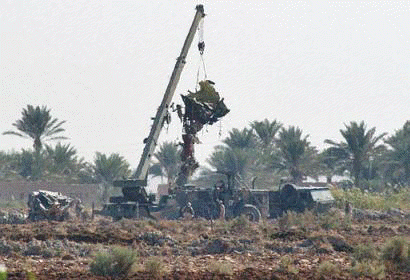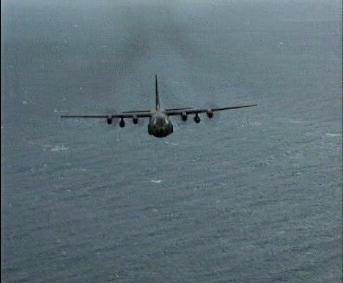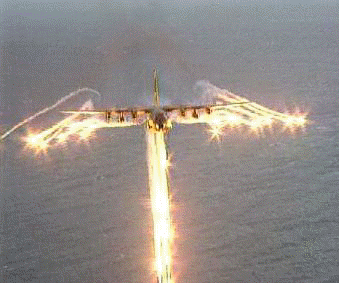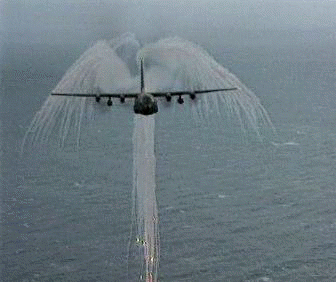
"Overlooking Runway 25 - Right, at Los Angeles International Airport"
CH-47D Air Mission To Baghdad
The Tragic Flight Home
&
Promise For Our Next Flights Home
Feature Date: November, 2003
The Air & Ocean Logistics- Customs Broker Attorneys
"Overlooking Runway 25 - Right, at Los Angeles International Airport"
On The Scene -- At Baghdad
In Memorial To 36 Troopers
of the
3rd Armored Cavalry Regiment

"Brave Rifles"
Details Below
|
|
|
Our Staff Attorneys & Law Firm Profile The Cargo Law Network - Correspondent Lawyers In The U.S. & Most Major Trading Nations Library & Search Engine of The Cargo Letter Search Engine For This Internet Portal - Find Everything You Need Transport Reference Desk - Virtual Transport Library |
24 Hour Int'l Vessel Casualties & Pirates Database The Photo Gallery of Cargo Loss - Photos & Lessons Learned Transport Law Navigator - all air, ocean, motor & customs laws Library & Search Engine of The Cargo Letter Mega Portal of Trade & Transport References And Services General Reference Desk - virtual public library |
|
TRANS
|
|
Use The Search Engine Here:
|
|
|
|
|
|
"Ship-To-Shore-Onto
Ship"
-
Nov. 2007
"Scheldt Snafu!" - M/V Grande Nigeria - Feb. 2006 because Ship Happens© "A Day At The Beach" - M/V APL Panama - Jan. 2006 "Curse of The Pequot" - M/V Maersk Holyhead - Jan. 2006 "NO Rails" - destruction of New Orleans - Dec. 2005 "Backhaul !" - for July 2005 "The Boeing Tri-Motor" - for April 2005 "Catch of The Day" - for March 2005 "One Brick Short of A Runway" - for Jan. 2005 M/T Vicuna Explodes - for Jan. 2005 "Unstacked" - overboard & Dr. Beach - Nov. 2004 "Sea (to) Land Express" - May 2004 "Super Loss" - March 2004 "Rocknes Monster" - Feb. 2004 "On A Wing & A Prayer" - Jan. 2004 "Stepping In It" - Dec. 2003 "Pelican's Peril" - collision on River Scheldt - Aug. 2003 "Denise & Polargo" - a love story - July 2003 "Columbia River Round Up" - June 2003 "T-Boned" - historic collision at sea - May 2003 "Ramp-Age" - Feb. 2003 "Piñata" - breaking the box - Jan. 2003 "Halifax Hash"--M/V Maersk Carolina - Jan. 2003 |
"Thar She Blows!" - M/V Hanjin Pennsylvania - Nov. 2002 "T-E-U Bar-Be-Cue" - aftermath of the Pennsylvania "Container Pool" - a mystery - May 2002 "Strangers On My Flight" -- by Frank Sinatra - don't blame us - we only report this stuff! "Dropping In On The Trucker" - it happened again - April 2002 "UNDER Achiever" - tell your friends ! - March 2002 "White Planes Can't Jump" - trouble at Kuala Lumpur - dramatic! "Tell It To The U.S. Marines!" - A Symbol of Our Day of Infamy - Sept. 11 Heavy Metal - lifting the un-liftable object - Disaster at Monrovia July 2001 Rail Mate -- an Egyptian rail loss - Tragedy At Ain Sokhna July 2001 Meals: Ready To Explode - Navy container barbecue at Guam! June 2001 America West Kisses Concrete M/V Ville De Orion - stack shift at LAX U.S. Navy EP- 3 -- China Hostage Situation - Spring 2001 Attack On USS Cole (DDG-67) - - Dramatic Photos! M/V OOCL America - Feb. 2000 M/V APL China - world's greatest container disaster - Nov. 1998 M/V New Carissa - the ship that would not die - 1999 M/V Tampa Maersk "on a dock diet" Hanjin's Bad Stab - Under The Dock At Pusan, Korea - Exclusive Photo! |
 |
CH-47 Air Mission To Baghdad In Memorial To 36 Troopers of the 3rd Armored Cavalry Regiment "Brave Rifles" The Tragic Flight Home & Promise For Our Next Flights Home
|
 |
|
|
||
The Time: MorningThe Date: Sunday 2 Nov. 2003
The Place: Baghdad int'l Airport
|
|
|
On the morning of 2 Nov. 2003, a formation of two CH-47 Chinook helicopters of F Company, 106th Aviation Battalion, 12th Aviation Brigade carrying more than 50 souls moves toward the U.S. base at Baghdad Int'l Airport. These are mostly exhausted, battle weary soldiers going to the exit airport for well earned rest and recreation (R&R) flights abroad. |
|
|
|
 |
 |
|
Staff Sgt. Daniel Bader, 28, of Colorado Springs, Colo. Assigned to Air Defense Artillery Battery, 1st Squadron, 3rd Armored Cavalry Regiment, Fort Carson, Colo. Sgt. Ernest G. Bucklew, 33, of Enon Valley, Pa. Assigned to Support Squadron, 3rd Armored Cavalry Regiment, Fort Carson, Colo. Sgt. Steven D. Conover, 21, of Wilmington, Ohio. Assigned to 2nd Battalion, 5th Field Artillery Regiment, Fort Sill, Okla. Pfc. Anthony D. D'Agostino, 20, of Waterbury, Conn. Assigned to the 16th Signal Brigade, Fort Hood, Texas. Sgt. Paul F. Fisher, 39, of Cedar Rapids, Iowa* *Died at a hospital in Germany Spc. Darius T. Jennings, 22, of Cordova, S.C. Assigned to 2nd Squadron, 3rd Armored Cavalry Regiment, Fort Carson, Colo. Pfc. Karina S. Lau, 20, of Livingston, Calif. Assigned to the 16th Signal Brigade, Fort Hood, Texas. Sgt. Keelan L. Moss, 23, of Houston. Assigned to 2nd Battalion, 5th Field Artillery Regiment, Fort Sill, Okla. Spc. Brian Penisten, 28, of Fort Wayne, Ind. Assigned to Air Defense Artillery Battery, 1st Squadron, 3rd Armored Cavalry Regiment, Fort Carson, Colo. |
Sgt. Ross A. Pennanen, 36, of Shawnee, Okla. Assigned to 2nsd Battalion, 5th Field Artillery Regiment, Fort Sill, Okla. Sgt. Joel Perez, 25, of Rio Grande, Puerto Rico. Assigned to 2nd Battalion, 5th Field Artillery Unit, Fort Sill, Okla. First Lt. Brian D. Slavenas, 30, of Genoa, Ill. Assigned to F Company, 106th Aviation Battalion, Army National Guard, Peoria, Ill. Chief Warrant Officer Bruce A. Smith, 41, of West Liberty, Iowa. Assigned to Detachment 1, Company F, 106th Aviation Battalion, Army National Guard, Davenport, Iowa. Staff Sgt. Paul A. Velazquez, 29, of San Diego. Assigned to 2nd Battalion, 5th Field Artillery Regiment, Fort Sill, Okla. Spc. Frances M. Vega, 20, of Fort Buchanan, Puerto Rico. Assigned to the 151st Adjutant General Postal Detachment 3, Fort Hood, Texas. Staff Sgt. Joe N. Wilson, 30, of Crystal Springs, Miss. Assigned to 2nd Battalion, 5th Field Artillery Regiment, Fort Sill, Okla.  |
As Outlined Below ....
With "Angel Fire" -- Hope Renews For Civilian Aviation Security
Workhorse: The 10-ton CH-47 Chinook is a twin-turbine, tandem-rotor, heavy-lift transport helicopter. The helicopter is primarily used to move troops, artillery pieces, ammunition, fuel, water, barrier materials, supplies & equipment on the battlefield. The U.S. Army has operated a variety of CH-47 Chinook models since 1962. |
|
|
Manufacturer: Boeing Engine: Two Textron Lycoming T55-L712 engines Performance at 50,000 pounds: Sea level cruise: Top speed 184 mph |
Crew: Cockpit-crew: 3 Weights: Maximum gross: 50,000 pounds |
Lessons Learned in the loss of this CH-47D Chinook, piloted by 1st Lt. Brian D. Slavenas ...
-- Could Play A Role In Future Civilian Aviation Security

Wreckage of the CH-47D Chinook from F Company, 106th Aviation Battalion, Army National Guard, Peoria, Ill. is removed in the picture above. There is grief for both Americans & the world, given a great loss of life.But what of witnesses to the CH-47D Chinook shoot down who "reported having seen flares after the (terrorist) missile was launched?"
The Associated Press reported on November 7, 2003:
WASHINGTON (AP) - The Army helicopter shot down over Iraq last weekend apparently had a last-second warning of an approaching missile and managed to launch flares designed to draw the heat-seeking missile away, a senior Army official said. It is not clear why the defensive moves did not work, but the official, who discussed the attack investigation on condition he not be identified, said U.S. officials believe the shooter simply got in a "lucky shot."Those "flares" seen after the CH-47D Chinook was attacked on Nov. 2 2003 at Baghdad are a hint of a new civilian aviation security future.
Those helicopters had an ALQ-156 Defensive System, including a flare dispenser aboard -- standard equipment on all Chinooks, whether active duty or National Guard. *
The Chinooks are equipped to dispense"Angel Fire" -- Nov. 2 was just a "lucky shot."
* Some Chinooks in Iraq are equipped with a different missile alert system, called the ALE-47, but officials insist that while different in function, the ALE-47 is not necessarily more effective against all missile threats.

Following the many threats against civilian airliners by terrorists since 9-11, the U.S. Defense Dept. announced on 12 Nov. 2003 an intention to consider protecting passenger craft with the ALQ-156 Defensive System. Indeed, it is understood that El Al Airlines has equipped it's civilian airliners with this type of protection for some years.Like those brave troops of the 3rd Armored Cavalry Regiment over Baghdad -- soon Your next flight to Denver could employ this air defense technique.
ANGEL DECOY: The photo above is of a U.S. Air Force C-130 -- also equipped with the ALQ-156 Defensive System to repel heat seeking missiles. The pattern formed by these "decoys" are how they got their name... it's truly awesome!

Because "Angel Decoy" maneuvers are usually carried out in remote areas or over water, the general public does not normally get to see these exercises.

The ALQ-156 Defensive System has two parts - the 1st is the AlQ-156, the electronic part that plots the flight of the attack weapon & determines when to try to counter it. The 2nd part is the M-130 Dispenser that emits hot flares, designed to draw heat-seeking weapons away from the aircraft, and chaff -- aluminum designed to try to jam enemy radar.The ALQ-156 system is linked electronically with the flare & chaff canisters, and can be set either to automatically or manually dispense them once a missile is detected.
The U.S. Defense Dept. could not disclose whether the ALQ-156 system was in "automatic mode" at the time of the CH-47D Chinook shoot down on Nov. 2 2003, but described the system as "operational." However, the CH-47D Chinook was flying at only 200 to 300 feet -- the crew simply may not have had enough time to conduct a successful evasion. Still it was a "lucky shot."

This "Angel Decoy" maneuver is awesome -- but as this technology advances to the Int'l civilian aircraft fleet --
From Our Reader - 24 July 2008
I recently read your article referencing the events of Nov 2, 2003 in the shooting down of the Chinook in Iraq. As a member of the unit I was a little discouraged by the fact that not all of your information and references were correct.The Aircraft was 91-00230, an aircraft from Detachment 1, F 106th AVN in Davenport, IA. The unit's flag is in Peoria, IL; but half of the unit & aircraft are from Davenport, Iowa.
The aircrew flying 230 consisted of 5 soldiers. Those that passed away were:
CW4 Bruce Smith, was the Pilot in Command of the aircraft & was from Det 1 F 106th AVN in Davenport, IA1LT Brian Slavenas was the Pilot & was from F(-)106th AVN in Peoria, IL
SGT Paul Fisher was one of the Flight Engineers & was from Det 1 106th AVN in Davenport, IA
When we deployed, we all came together to be F Co 106th AVN. A lot of the info gets confused because we are in the company but we're not.
230 was equiped with the ALQ156 automated flare dispensing system, however the flare bucket was a M-130, 1 bucket. When the missile was shot at 230 which was Chalk 1 in a formation of 2, it didnt launch flares. The missile impacted the #2 (right) engine and the aircraft went down, it impacted hard enough that the aircraft crumpled and rolled stopping on the burm of a creek bed. Chalk 2, aircraft 243 did manually launch flares as they performed evasive maneuvers.
The place was 9 nm east of the Al Taqaddum airbase (TQ for short) in Fallujah, Iraq. The aircraft was flying from Al Asad air base in western Iraq to Ramadi, to TQ, to St. Mere, to Baghdad Internation Airport (BIAP) to drop off soldiers going home on leave. The incident happened on the way from TQ to St. Mere.
After the incident the army updated the National Guard aircraft with a new flare dispensing system called the ALE 47 which had 2 buckets on each side. It still relied on the ALQ 156 to detect the incoming threat. At no time has it ever been referenced as Angel Fire. The picture you show of the C-130 is the only time anyone has ever called launching flares angelfire because it looks like an angel when launched from that aircraft.
I hope that you will update the info, its great to see the story out there, however correct information would be best.
Sincerely,Jason Rassi, CW3, AV - B 2-238th GSAB (formerly F(-)106th AVN), Peoria, IL
Our "Angel
Fire" INDEX For This Feature
--
3rd Armored Cavalry Regiment3rd Armored Cavalry RegimentProtecting Airliners From Terrorist Missiles - The proliferation of shoulder-fired surface-to-air missiles poses a growing threat to all forms of air traffic. This newly updated report from the Congressional Research Service surveys the options for addressing the threat.
The ALQ-156 Defensive System (UNCLASSIFIED)
GENERAL: The AN/ALQ-156(V)3 Missile Approach Detector is an airborne radar system which provides infrared homing protection to the aircraft by detecting the approach of anti-aircraft missiles. Upon detection of an on-coming missile, the missile detector automatically initiates a signal that triggers the M-130 General Purpose Dispenser System. The dispenser system then releases a flare to decoy the infrared missile(s) away from the aircraft. This system has been transitioned to Communications-Electronics Command (CECOM).PHYSICAL CHARACTERISTICS: The AN/ALQ-156(V)3 Missile Approach Detector consists of a receiver/transmitter (RT), a control indicator and four identical planar slot antennas. The RT is equipped with a built-in-test capability for the system. The total system weight is 63.8 pounds.
THREAT COVERAGE: The AN/ALQ-156(V)3 Missile Approach Detector and M-130 Dispenser with flares are designed to provide protection against present and near-term infrared homing missile threats.
AN/ALQ-156A MAWS Missile Approach Warning System
AN/ALQ-156A MAWS Missile Approach Warning SystemThe Aircraft Presented In This Feature:
C-130 Hercules U.S. Air Force
U.S. Air ForceLockheed Photo Vault - the builder
System Program Office - continued manufacture
CH-47 Chinook....
Boeing - the manufacturerCH-47D - the model in this feature
Take A Break - Our LAX Videdo - Home Theme! - this is where your Cargo Letter staff lives!
Special Thanks To
Contributors For Our
"Angel
Fire"
Feature
Mr. Aaron White, Southwest Airlines, Customer Relations, Headquarters Executive Offices, Dallas, TX.Mr. Blaine Prentiss, Countryman & McDaniel - for research
Thanks to our contributors,McD
NOTE: Please Provide Us With Your Additional Information For This Loss.
EDITOR'S NOTE FOR SURVEYORS, ATTORNEYS & MARINE ADJUSTERS: The Internet edition effort of The Cargo Letter now celebrates it's 9th Year of Service -- making us quite senior in this segment of the industry. We once estimated container underway losses at about 1,500 per year. Lloyd's put that figure at about 10,000 earlier this year. Quite obviously, the reporting mechanism for these massive losses is not supported by the lines. News of these events is not posted to the maritime community. Our new project is to call upon you -- those handling the claims -- to let us know of each container loss at sea-- in confidentiality. Many of you survey on behalf of cargo interests with no need for confidentiality. Others work for the lines & need to be protected. As a respected Int'l publication, The Cargo Letter enjoys full press privileges & cannot be forced to disclose our sources of information. No successful attempt has ever been made. If a personal notation for your report is desired -- each contributor will be given a "hot link" to your company Website in each & every report. Please take moment & report your "overside" containers to us. If you do not wish attribution, your entry will be "anonymous." This will will benefit our industry -- for obvious reasons! McD
NOTE: The Cargo Letter wants you to know that by keeping the identity of our contributors 100% Confidential, you are able to view our continuing series of "Cargo Disasters." Our friends send us materials which benefit the industry. The materials are provided to our news publication with complete and enforceable confidentiality for the sender. In turn, we provide these materials to you.
| Cargo law Main Page | The Freight Detective | Law Navigator | Claims Calculator |
| The Freight Detective General Investigations | The Freight Detective Transport Investigations |
| The Logistics Chain | Photo Gallery of Cargo Loss | Our Staff |
| Trans-Cams | Forwarder/Broker Industry Chat & Issue Discussion Board |

The Law Offices of Countryman & McDaniel
Eleventh Floor LAX Airport Center
5933 West Century Boulevard
Los Angeles, California, 90045
(310) 342-6500 Voice
(310) 342-6505 Fax
![]() to
The Law Offices of Countryman &
McDaniel
to
The Law Offices of Countryman &
McDaniel